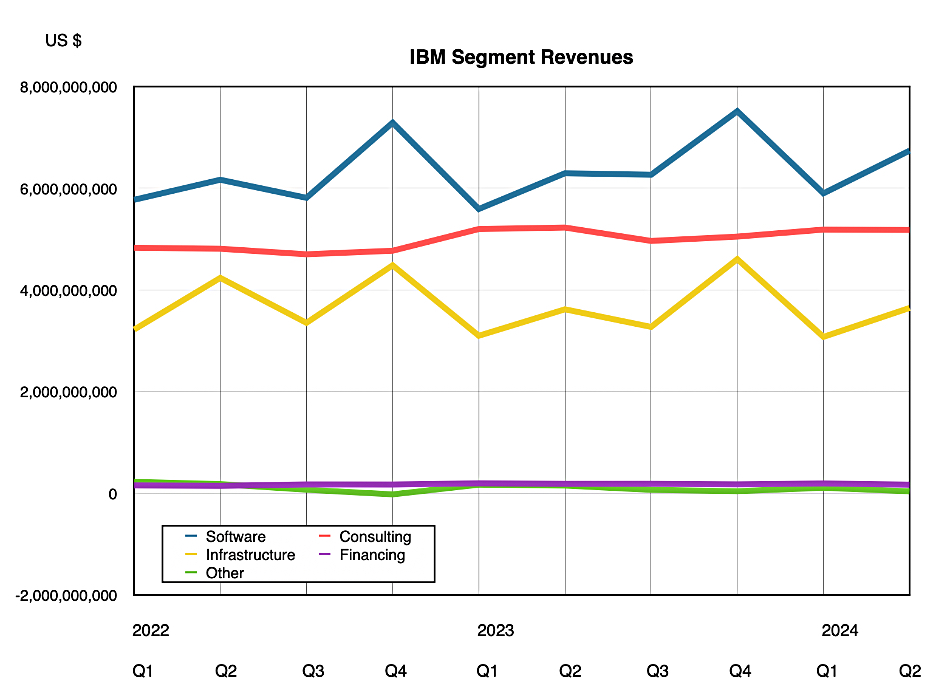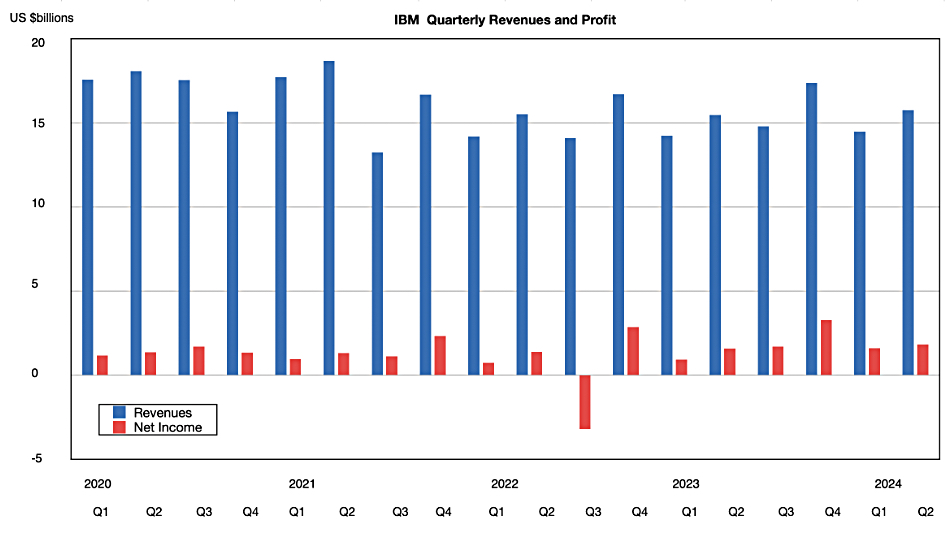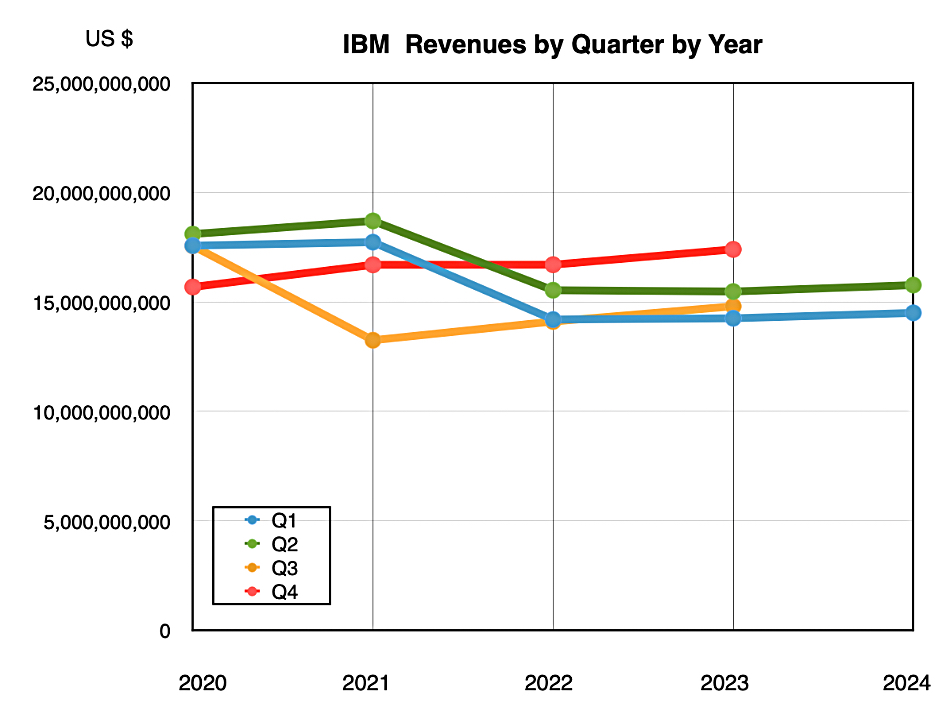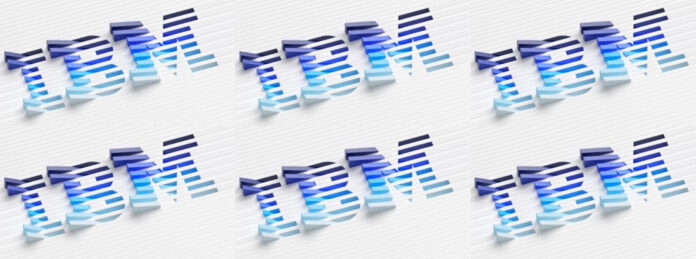IBM revenues for the second 2024 quarter rose 2 percent year-on-year to $15.8 billion, beating Wall Street estimates, as its hybrid cloud and AI strategy paid off with a 7 percent rise in software sales helping to lift profits 16 percent to $1.83 billion.
The software business pulled in $6.74 billion, consulting revenues languished in comparison at $5.2 billion, down 0.9 percent. The smaller infrastructure business brought in $3.65 billion, up 0.7 percent on the year, with financing earning $169 million, 8.3 percent down on the year.

CEO Arvind Krishna said in prepared remarks: “We delivered a strong quarter, exceeding our expectations, driven by solid revenue growth, profitability, and cash flow generation. We had strong performance in Software and Infrastructure, above our model, as investment in innovation is yielding organic growth, while Consulting remained below model. Our results underscore the continued success of our hybrid cloud and AI strategy and the strength of our diversified business.
”Technology spending remains robust as it continues to serve as a key competitive advantage allowing businesses to scale, drive efficiencies and fuel growth. As we stated last quarter, factors such as interest rates and inflation impacted timing of decision-making and discretionary spend in Consulting. Overall, we remain confident in the positive macro-outlook for technology spending but acknowledge this impact.”
Financial Summary
- Gross profit margin: 57.8 percent, up 190 basis points year-on-year
- Operating cash flow: $2.1 billion, down $0.6 billion year-on-year
- Free cash flow: $2.6 billion, up $0.5 billion (24 percent) year-on-year
- Cash, restricted cash and marketable securities: $16 billion, up $2.5 billion from year end 2023
- Debt: $56.5 billion, flat year-on-year
- EPS: $1.96
IBM has “infused AI across” its business, with Krishna saying: “In software, our broad suite of automation products like Apptio and watsonx Orchestrate are leveraging AI and we expect to do the same with HashiCorp, once the acquisition is complete. Red Hat is bringing AI to OpenShift AI and RHEL AI. In Transaction Processing we’re seeing early momentum in watsonx Code Assistant for Z. In Infrastructure, IBM Z is equipped with real time AI inferencing capabilities. And in Consulting, our experts are helping clients design and implement AI strategies.”
Its hybrid cloud area is now AI-centric as well: ”Hybrid cloud remains a top priority for clients as flexibility of deployment of AI models across multiple environments and data sovereignty remain a key focus.”
Generative AI is surging, claims the biz: “Our book of business related to generative AI now stands at greater than $2 billion inception to date. The mix is roughly one-quarter software and three-quarters consulting signings.”
This GenAI interest in its customer base is driving IBM’s compute (z16 mainframe) and storage business: “z16’s Telum processor is a unique differentiator, driving real time, in-line AI inferencing at unprecedented speed and scale for applications like real-time fraud detection. Our storage offerings are also benefiting from generative AI as clients address data readiness and need high-speed access to massive volumes of unstructured data.”

SVP and CFO Jim Kavanagh, using constant currency percentages, said: “Software grew by 8 percent, with solid growth across Hybrid Platform & Solutions and Transaction Processing, and strong transactional performance. Infrastructure had great performance, up 3 percent, delivering growth across IBM Z and Distributed Infrastructure. Consulting was up 2 percent and continued to be impacted by a pullback in discretionary spending.
“Transaction Processing delivered 13 percent revenue growth. This performance demonstrates the innovation and value of our mission critical hardware stack across IBM Z, Power and Storage.”

The infrastructure business segment is divided into a hybrid infrastructure segment and an infrastructure support (hardware and software) business. The hybrid infrastructure is further divided into the Z mainframe and OS business, and distributed infrastructure: Power server hardware and OS, storage hardware, IBM Cloud IaaS, and OEM asset recovery service.
Hybrid infrastructure revenues were $2.4 billion in the quarter with infrastructure support earning $1.3 billion.
For hybrid, Kavanaugh said: “IBM Z revenue was up 8 percent this quarter. We’re now more than two years into the z16 cycle and the revenue performance continues to outperform prior cycles … Increasing workloads translates to more Z capacity or MIPS, which are up about threefold over the last few cycles.
“In Distributed Infrastructure, revenue grew 5 percent driven by strength in both Power and storage. Power growth was fueled by demand for data intensive workloads on Power 10 led by SAP Hana. Storage delivered growth again this quarter, including growth in high-end storage tied to the z16 cycle and solutions tailored to protect, manage and access data for scaling generative AI.”
As ever with IBM results, we don’t know the storage hardware and OS revenue number, nor the storage software revenues, which would include Storage Scale, Ceph, data protection and so forth, and be included in IBM’s Software segment’s revenue number.
Kavanaugh’s summation of the quarter was: ”We are pleased with our performance this quarter and for the first half, driving confidence in our updated expectations. We are positioned to grow revenue, expand operating profit and grow free cash flow for the year.”
Krishna said: ”Given our first-half results, we are raising our full-year view of free cash flow, which we now expect to be more than $12 billion.” The free cash flow full (FCF) year estimate was previously about $12 billion.
Bootnote
IBM has a strong focus on FCF, the cash remaining after it’s paid for business operations and maintaining its capital assets. FCF is the source of dividends, debt payments, reinvestment in IBM’s business, and acquisitions. Investors and analysts can prefer FCF as a business health metric over profit (net income) because it can be a more accurate measure of financial health.








